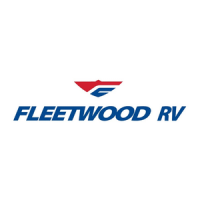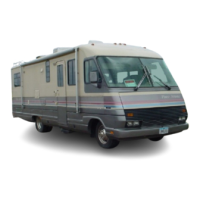LiviNG
WiTh
YOUR
MOTOR
HOME
Your
RV
was designed primarily for recreational use and
short term occupancy.
If
you plan
to
stay in it for longer than
a couple
of
days, you need to understand how to properly
manage and control the humid conditions and condensation
that you may experience.
Modern
RVs
are much smaller than a house, and are tightly
built. This means that the interior air will become saturated
with moisture more quickly. The routine activities
of
a few
people can put a lot
of
water into the
air.
In cold weather,
this moisture may become visible
as
condensation.
Condensation happens naturally. Just
as
moisture collects on
the outside
of
a glass
of
cold water during humid weather,
moisture can condense on the inside surfaces
of
your
RV
during cold weather when the humidity
of
the interior air is
high.
Water vapor will condense on the inside
of
the windows and
walls. In really cold weather, frost or ice may appear.
It
may
also condense out
of
sight within the walls or the ceiling.
If
enough water collects in the wall or ceiling materials, it may
cause water stains on the wall or ceiling surface.
You
might
think that your walls or ceiling are leaking.
You
have a prob-
lem with condensation
if
you see these signs.
You
need to do
something
to
reduce the moisture inside your
RY.
If
you locate your
RV
in an area that experiences cold winter
temperatures, you may experience the effects of condensa-
tion. Even though you
can't
eliminate it completely, you can
reduce or eliminate its effects.
PACE
ARROW
EFFECTS OF
PERMANENT
OCCUPANCY
CONDENSATION
AND
How
TO
CONTROL
IT
.(\
NOTE
Your
RV
is
not designed
to be used as permanent
housing. Use
of
this
product for long term or
permanent occupancy
may lead
to premature
deterioration
of
structure,
interior finishes, fabrics,
carpeting and drapes.
Damage
or
deterioration
due
to long term occu-
pancy may not be
considered normal, and
may under
the
terms
of
the warranty constitute
misuse, abuse, or
neglect, and may
therefore reduce your
warranty protection.
~
1-----:-:-=

